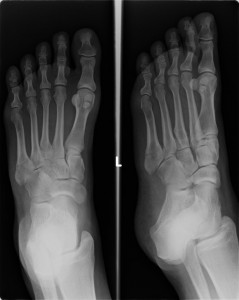Your next patient is a 27 yo woman who inverted her foot while playing netball and is now unable to weight bear due to pain.
This is her Xray:
You know there are 2 types of fractures of the base of the 5th metatarsal, one good and one bad. Which is which?
The more common is a fracture of the tuberosity of the base of the 5th metatarsal. It usually occurs secondary to sudden inversion of a plantar-flexed foot and can masquerade as an ankle sprain (and that is why if somebody presents with a painful ankle you should palpate the base of the 5th metatarsal as well).
It is extraarticular and has good prognosis.This fracture is managed with walking cast / compression wrap or cam boot walker for 2-3 weeks.
The less common but also more serious is a transverse fracture of the base of the 5th metatarsal (Jones fracture) – this is what our patient has. It involves the 4th/5th intermetatarsal articulation and occurs in sports that involve jumping or running.
Treatment of non-displaced fractures is non-weight-bearing cast applied in ED and close Orthopaedics follow-up. They usually have a repeat Xray at 6 – 8 weeks, but they often end up non-weight bearing for a few months.
Displaced fractures should be reduced in ED before casting. They often require internal fixation, same as fractures that occur in elite sports players.


Do you have a resource for 5th MT reductions? Never seen or done it.
I’ve never done it or seen it being done myself, as all the patients I had with displaced 5th metatarsal fractures went to theatre for ORIF. However, according to Roberts, to reduce a 5th metatasal fracture you need to increase the deformity first (either extension or plantar flexion depending on the initial displacement), then applying traction while exerting thumb pressure over the base of the displaced fragment. The majority of displaced metatarsal fractures will need surgery though.
Mgmt is really a cast in the ED, not a splint?